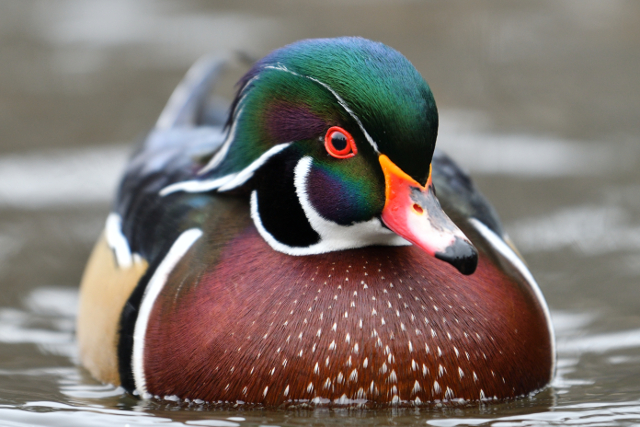
Male Wood Duck.
Photo by G. Scott Segler, (CC.4.0 )
Wood Ducks are stunning. They’re the best dressed waterfowl in the United States. Donna Karan, Pierre Cardin, and Versace can’t begin to compete with this bird. And while the female of the species is drab, the males sport Armani suits.
Why People are protecting Wood Ducks
Wood Ducks are secretive creatures, dwelling in forested areas along waterways. They eat acorns, agricultural grains, plant seeds, and invertebrates. They prefer to forage in shallow water in morning and evening.
Their nesting behavior is as striking as their plumage. Wood Ducks are cavity nesters. They seek hollow cavities that develop naturally in older trees. When the ducklings are only 15-24 hours old, they leave the nest in dramatic fashion:
You can imagine what’s coming next…
When humans drained and cleared wetlands to build cities, California lost more than 90% of its riparian forests. Wood Ducks depend on this habitat for survival.
So conservation groups have been building and maintaining nest boxes to replace the natural cavities lost to habitat destruction. Most of these programs are staffed by volunteers (citizen scientists), who build, deploy, and monitor the boxes. The data they collect helps build a picture of Wood Duck population in the state.
Fortunately, the birds seem willing to nest in these artificial cavities.
Wood Ducking
I recently delivered a talk on Teaching Stewardship through Bushcraft at the NAI Region 9 Workshop. The National Association for Interpretation (NAI) is the professional organization for nature and heritage interpreters. Members work at parks, museums, nature centers, zoos, botanical gardens, aquariums, historical sites, cultural sites, commercial tour companies, and theme parks.
After my program, I attended a wonderful session about Wood Ducks. It’s presented by Cat Taylor, Naturalist and Volunteer Coordinator at the East Bay Regional Park District. She described the district’s nest box program and long-term study of Wood Ducks. Her team of citizen-scientist-volunteers monitors and maintains the boxes.
But that’s not all!
After a brief introduction, she gathers our small group and leads us to a nearby stream to conduct a survey of the district’s nest boxes.
Counting Wood Ducks is not like Counting Sheep
Our team heads into the woods with some special equipment: A six-foot stepladder, a “plugger”, and bags of wood shavings.

Hiking into the woods with our stepladder and bag of wood shavings.
The sky is brilliant blue as we stroll underneath oaks that grow along the stream. What could be an oppressively hot day is cool and pleasant under the trees. Grasses sway as the gentle breeze carries the scent of Mugwort and California Sagebrush. It’s a perfect afternoon.
Debris washed downstream by recent floods litters the gravel banks that protrude into the shallows. Some of it is natural, but most is man-made detritus unearthed by the floodwaters. We find a toy boat run aground in the low-hanging branches of a shrub. “Made in America” is stamped into the injection molded plastic. We may have found an ancient shipwreck!
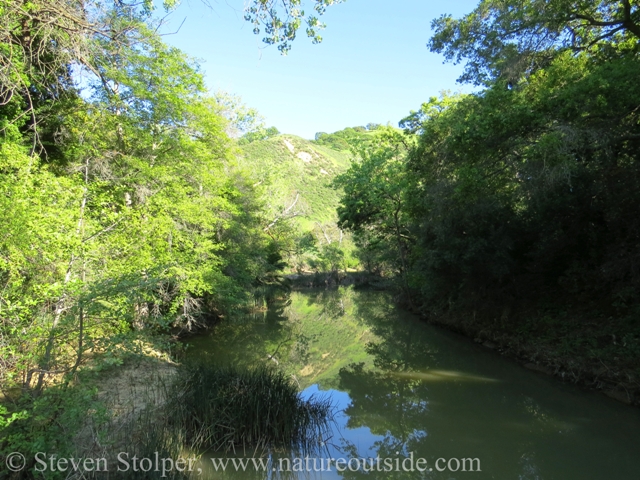
The stream flows across the floor of the valley.
The Wood Duck Nest Box
The nest boxes are built to standards specified by the non-profit California Waterfowl Association. The hole needs to be high above the floor so that a raccoon cannot reach in and grab the female on the nest.
Grooves cut into the interior and exterior of the box allow the ducks purchase as they enter and exit. In the pictures below, a Flicker has been trying to enlarge the entrance to one of the boxes for its own use.
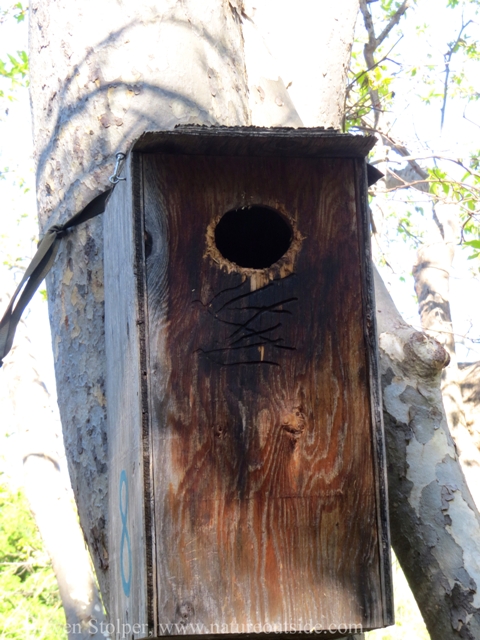
Wood Duck nest box. Notice the hook and eyelet that fastens the removable lid. The nylon strap tied around the tree helps volunteers balance at the top of the ladder.
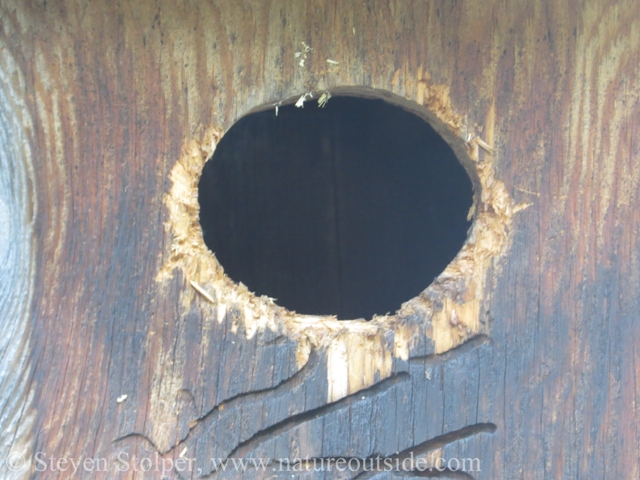
Cat thinks a Flicker has tried to widen the entrance so it can use the box. The grooves were made with a router to give the birds purchase as the enter and exit.
The boxes are attached to trees along the riverbank. They’re suspended only six feet above the ground. This makes them easier to survey by the adults and school age children who volunteer to maintain them.
Peeking In
The first step is to plug the entrance to the box. If there is a female on the nest, we don’t want to flush her. As long as we are quiet and subtle, we won’t stress the duck.
A volunteer creeps slowly toward the box. Slipping around to the side with the entrance, the volunteer plugs the opening with a cut-out that fits the hole. The cutout is mounted on the end of a pole that acts as a handle.
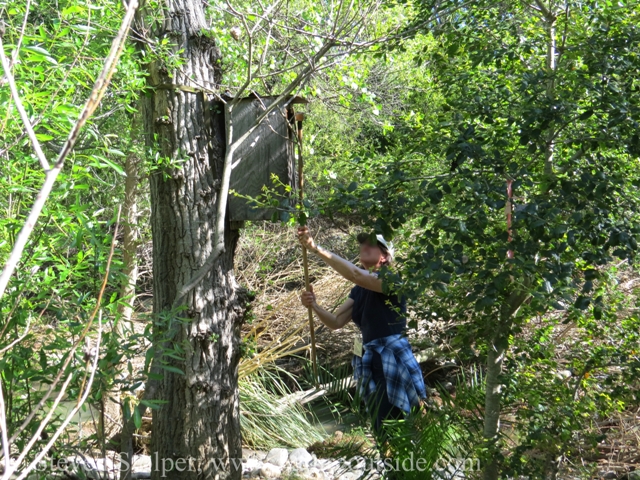
A volunteer uses the “Plugger” to block the entrance.
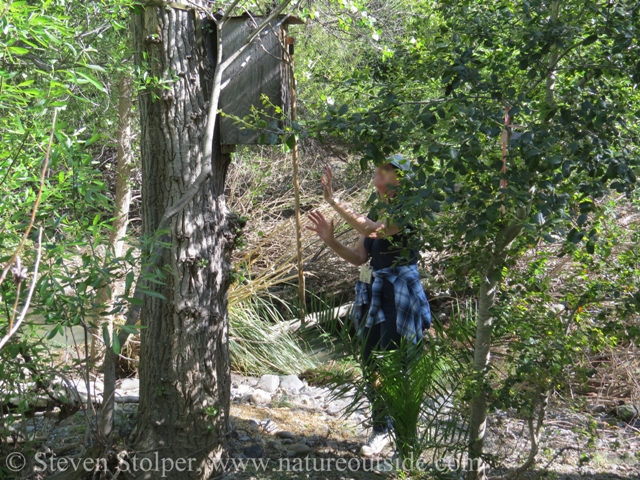
Once inserted, the cutout is thick enough that it remains in the hole.
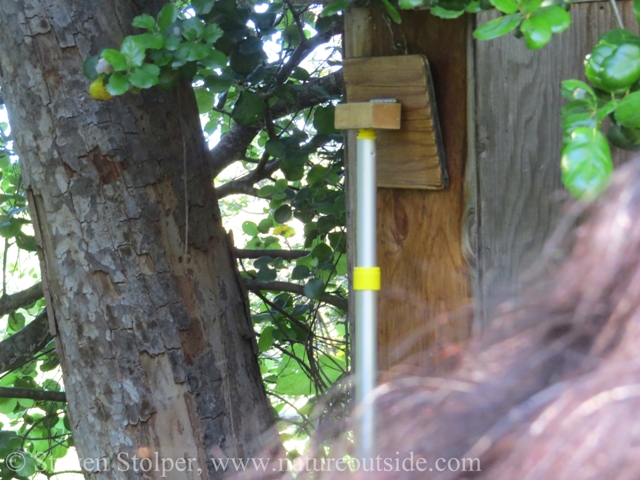
A closer view of the Plugger.
Once the entrance is plugged, we use the stepladder to climb the tree. Cat thoughtfully placed nylon straps around the trees above the nest boxes. The handholds makes it easier to balance at the top of the ladder.
The boxes have a metal hook and eyelet that keep the lids on securely. The volunteer at the top of the ladder unhooks the lid and lifts it a crack. Peeking into the box, the volunteer signals if there is a duck inside.
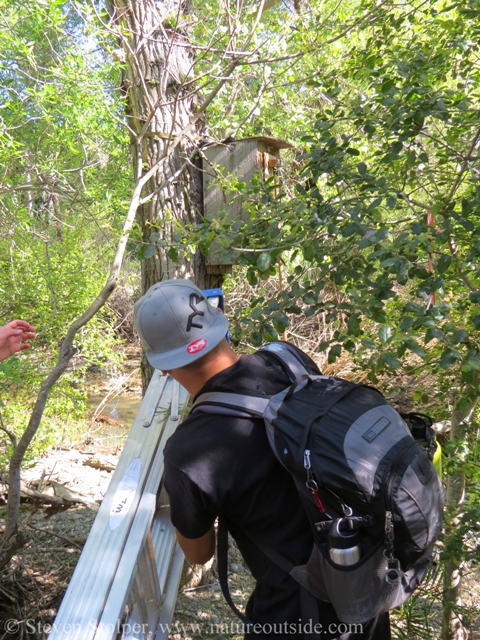
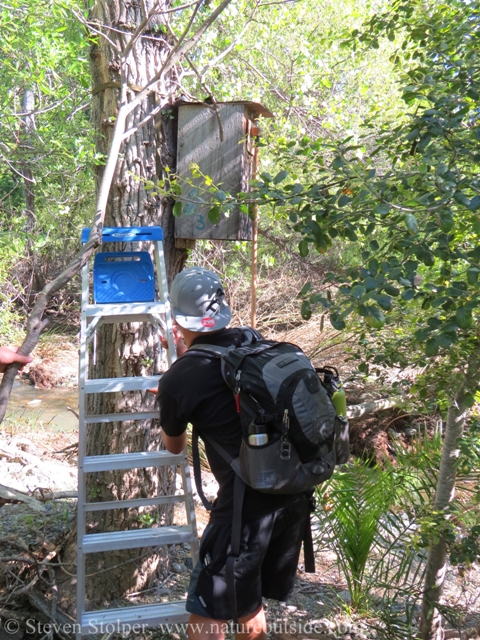
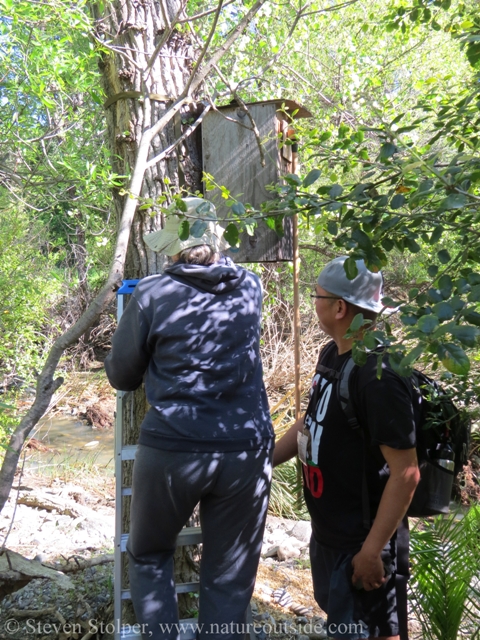
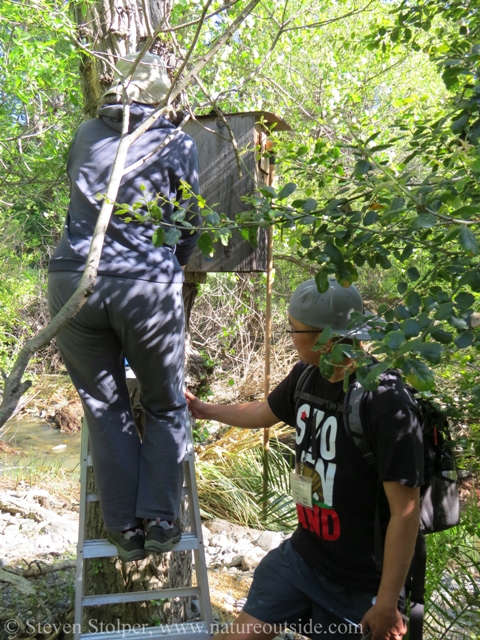
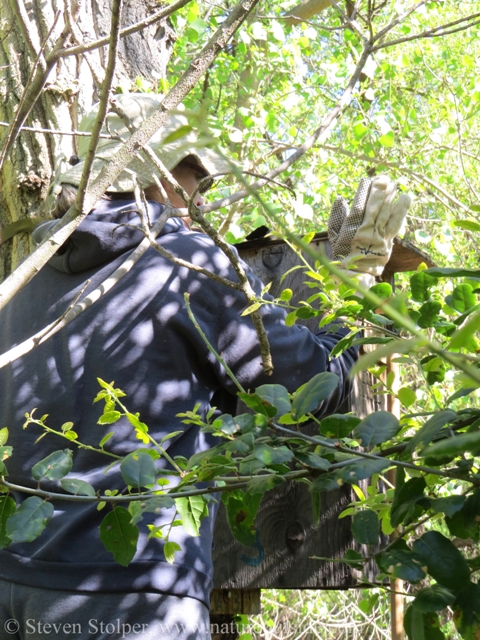
Opening the nest box.
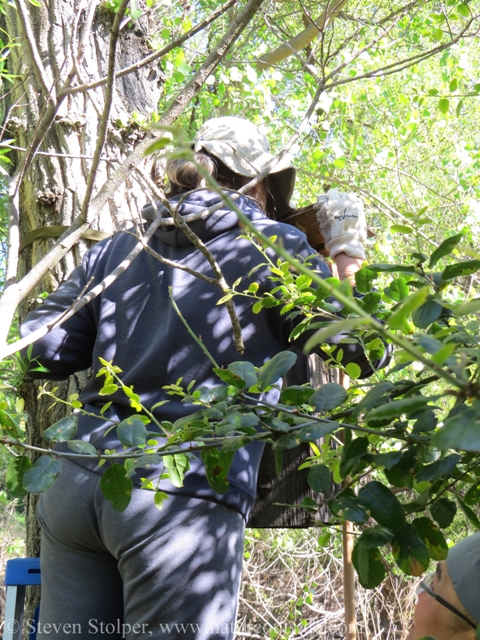
Peeking into the nest box
The box interior has a bed of wood shavings. Wood Ducks nest in the debris that accumulates on the floor of natural cavities. The wood shavings serve the same purpose. The shavings need to be approximately four inches deep because the females cover the eggs with up to two inches of debris.
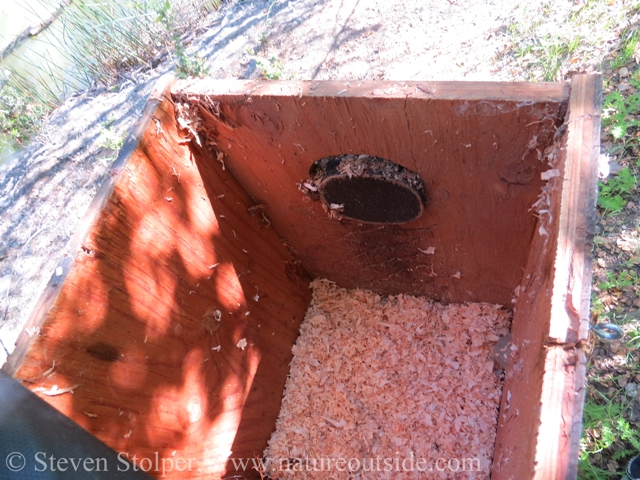
A look inside the Wood Duck nest box. The “Plugger” blocks the entrance.
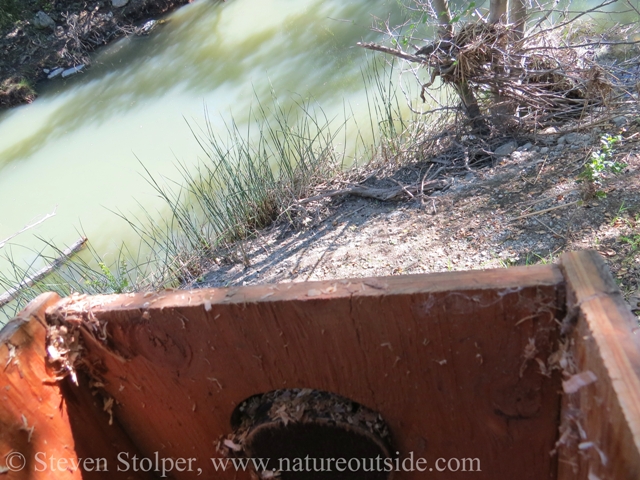
The view from the nest box
We clean the lid of spiderwebs while a volunteer inspects the nest box. Is there a duck sized depression in the wood shavings? We plunge our hands into the shavings looking for buried eggs.
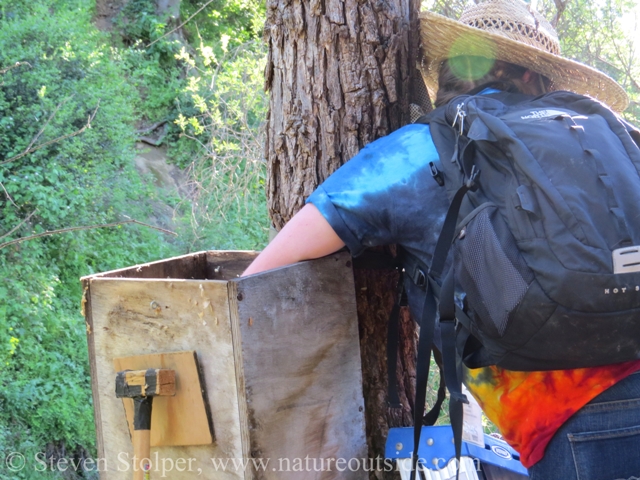
Searching for eggs buried in the wood shavings.
Calling down from the ladder, we report the condition of the nest box to others who are recording the data.
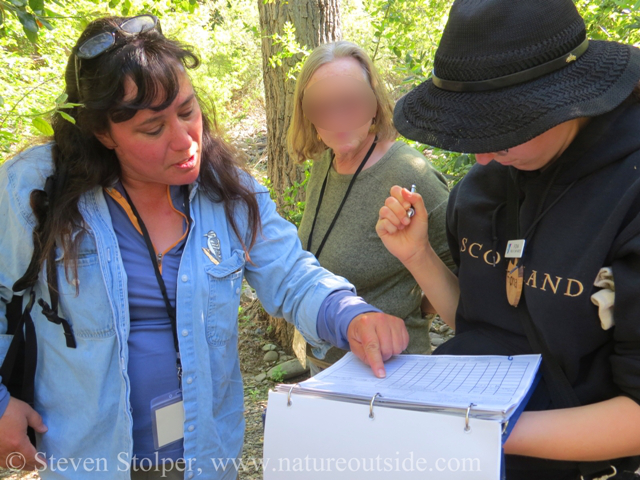
Cat Taylor works with a volunteer recording the data.
We don’t find any ducks or eggs. It’s what Cat expects this early in the season. But two of the nest boxes have depressions. Could females be scouting for nest locations?
We replace wood shavings in two of the boxes because the material seems moist from recent rains. We note on the data sheet to replace the rubber flaps that help keep rain out of the boxes.
Job Done
We inspect about five boxes and head home. It’s a great experience and I learn a lot.
Interested in volunteering with a Wood Duck conservation project? Look on the Internet for one near you.
Related Articles on NatureOutside
Acorn Woodpecker – This Bird is Nuts! (Video)
To See More Wildlife, Learn Bird Language
Birds Think You are a Scary Dinosaur!
For fun facts and useful tips, join the free Bushcraft Newsletter.

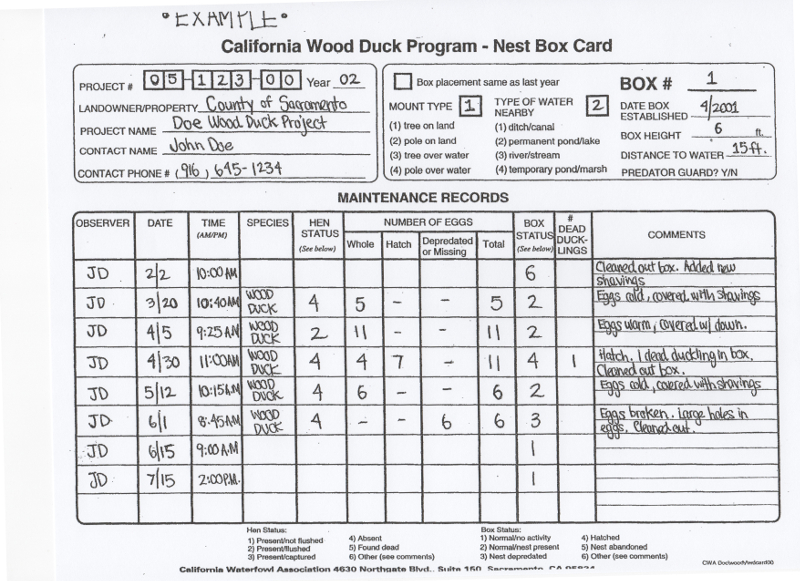


Leave a Comment